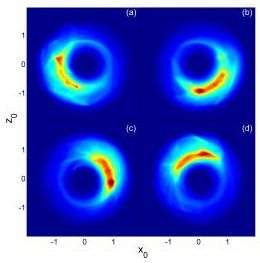Physicists create millimeter-sized 'Bohr atom'

Nearly a century after Danish physicist Niels Bohr offered his planet-like model of the hydrogen atom, a Rice University-led team of physicists has created giant, millimeter-sized atoms that resemble it more closely than any other experimental realization yet achieved.
The research is available online in Physical Review Letters.
Bohr offered the first successful theoretical model of the atom in 1913, suggesting that electrons traveled in orbits around the atom's nucleus like planets orbiting a star. Bohr's model led to a deeper understanding of both the chemical and optical properties of atoms and won him a Nobel Prize in 1922. But his notion of electrons traveling in discrete orbits was eventually displaced by quantum mechanics, which revealed that electrons don't have precise positions but are instead distributed in wave-like patterns.
"In a sufficiently large system, the quantum effects at the atomic scale can transition into the classical mechanics found in Bohr's model," said lead researcher Barry Dunning, Rice's Sam and Helen Worden Professor of Physics and Astronomy. "Using highly excited Rydberg atoms and a series of pulsed electric fields, we were able to manipulate the electron motion and create circular, planet-like states."
The team included members from Oak Ridge National Laboratory and Vienna University of Technology. Using lasers, the researchers excited potassium atoms to extremely high levels. Using a carefully tailored series of short electric pulses, the team was then able to coax the atoms into a precise configuration with one point-like, "localized" electron orbiting far from the nucleus. In fact, the atoms are true atomic giants, with diameters approaching one millimeter.
"Our measurements show that the electrons remain localized for several orbits and behave much as classical particles," Dunning said.
He said the work has potential applications in next-generation computers and in the study of classical and quantum chaos.
Source: Rice University




















